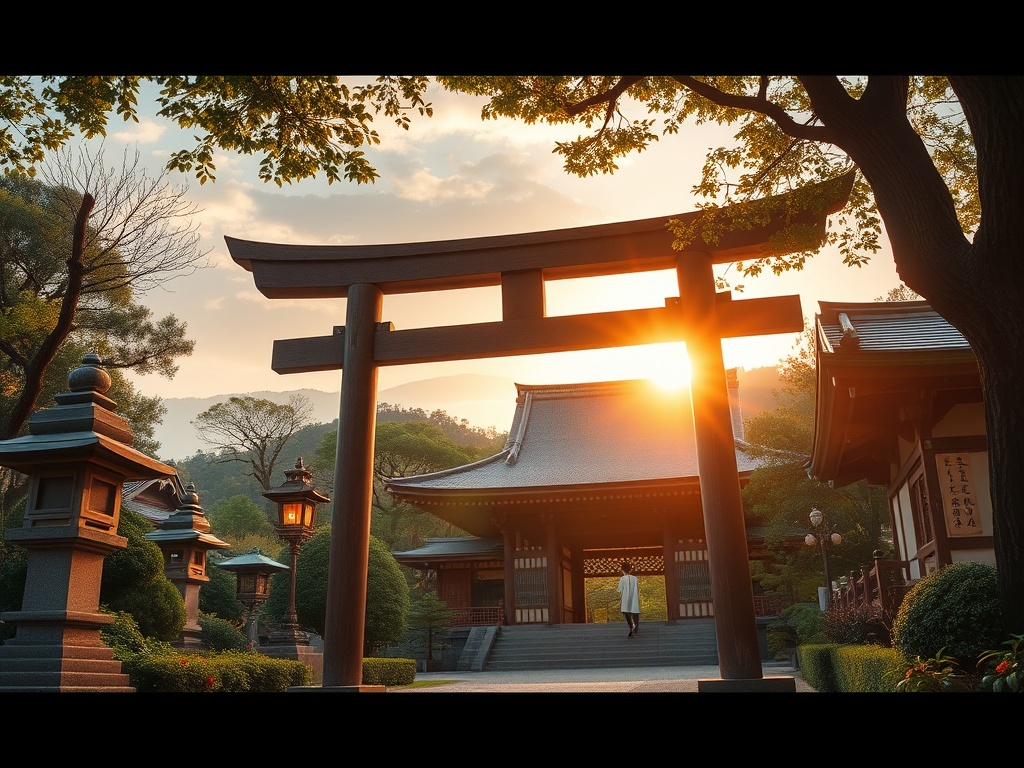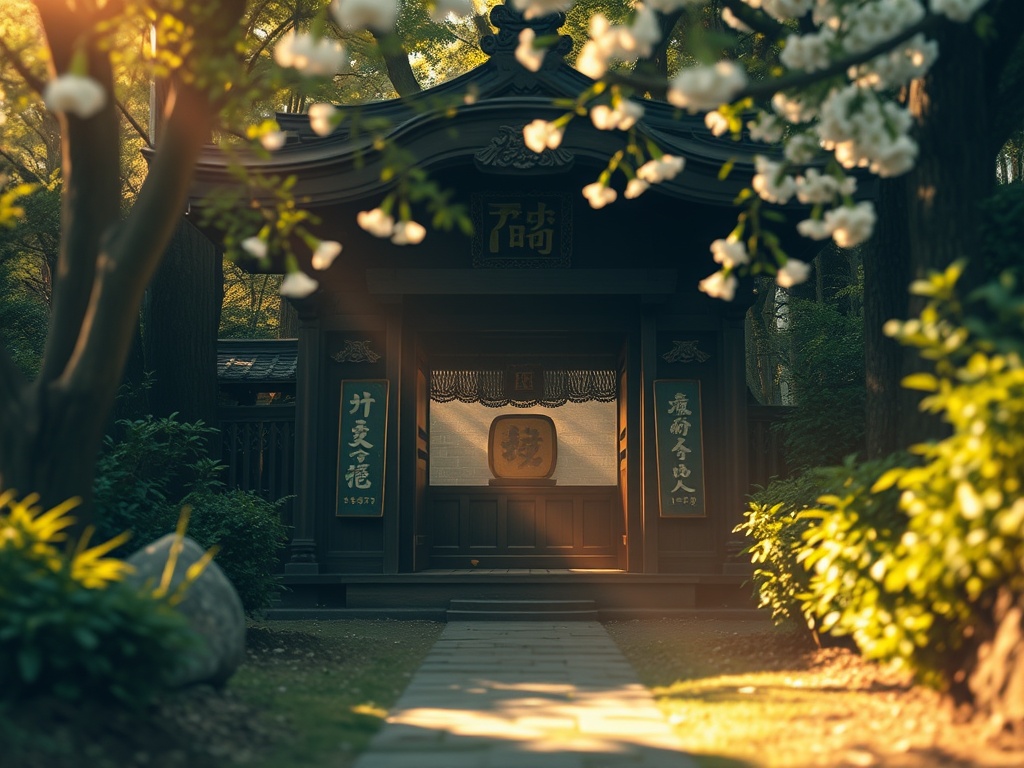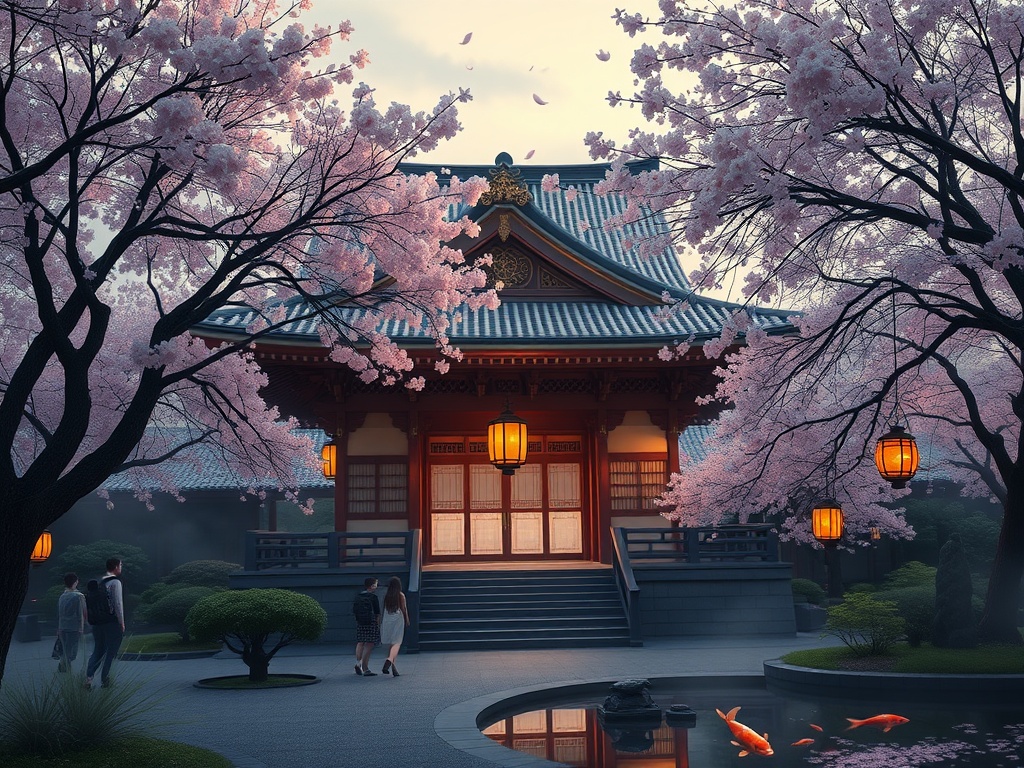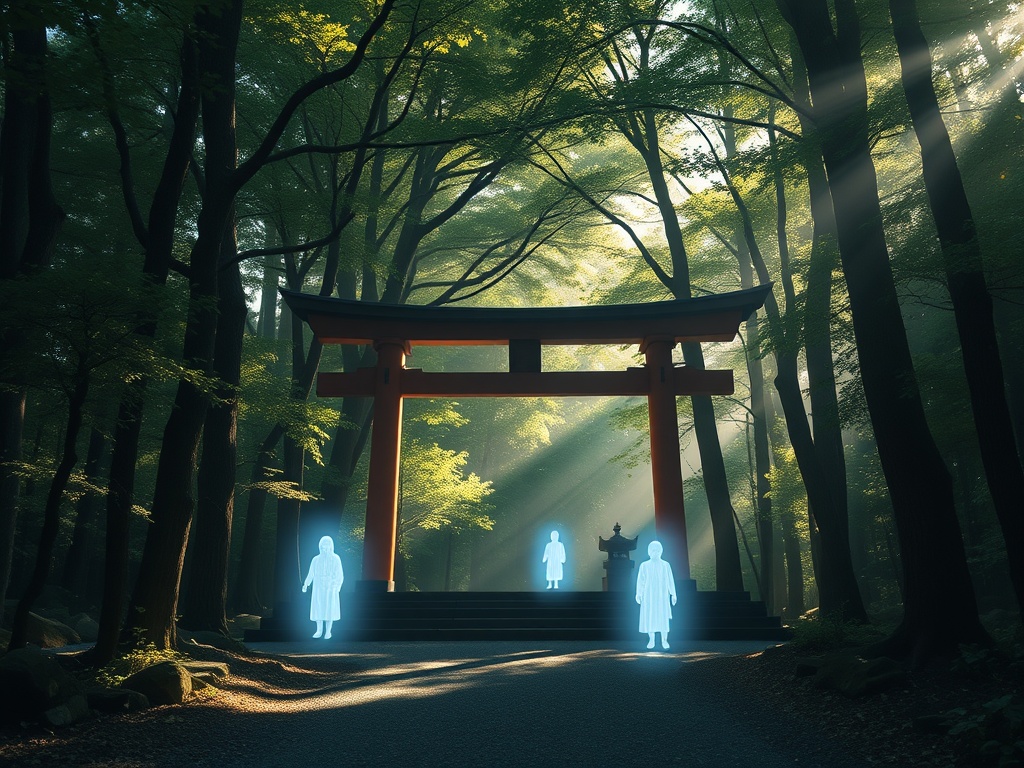Whispers of the Divine: Discovering Tokyo’s Hidden Shrines
Win a Free Trip to Japan!
Experience cherry blossoms and ancient temples
Tokyo, a metropolis that dazzles with neon lights and skyscrapers, holds secrets of a different kind. Beneath its modern facade lies a mystical world of hidden shrines, where whispers of the divine echo softly amidst the hustle and bustle. These sacred sites, often overshadowed by the city’s towering giants, offer a serene escape and a peek into the spiritual tapestry that weaves through Japan’s capital. Set off on a journey to uncover Tokyo’s lesser-known sanctuaries, where history and spirituality meet in quiet harmony.
While many travelers flock to the grand temples of Asakusa and Meiji Shrine, there exists a network of lesser-known shrines tucked away in the city’s labyrinthine streets. These places, often devoid of crowds, provide a rare opportunity to connect with the spiritual heart of Tokyo.
Here is a list of some of Tokyo’s hidden shrines that promise tranquility and a sense of the sacred:
- Yushima Tenjin: Known for its plum blossoms, this shrine is a haven for students seeking blessings for academic success.
- Akasaka Hikawa Shrine: Nestled in a quiet neighborhood, it’s a perfect spot to enjoy a moment of peace and natural beauty.
- Nezu Shrine: Famous for its azalea festival, this historical site boasts stunning architecture and lush gardens.
Visiting Tokyo’s shrines isn’t just about sightseeing; it’s an invitation to partake in timeless rituals that have been practiced for centuries. As you wander these sacred grounds, consider engaging in some of these spiritual practices:
- Purification: Cleanse your hands and mouth at the chozuya to prepare for your spiritual journey.
- Prayer: Offer a silent prayer or wish at the altar, accompanied by a gentle bow and a heartfelt clap of hands.
- Fortune Telling: Try your luck with an omikuji fortune slip, a traditional way to seek guidance from the gods.
The Sacred Pulse: Tokyo’s Temples and Their Mystical Tales
Amidst the bustling streets and modern marvels of Tokyo lies a deep-seated spirit that beats softly yet powerfully. The city’s temples are not just architectural wonders; they are living stories of faith, resilience, and mysticism. Each temple holds within its walls a chronicle of the past, offering visitors a chance to step back in time and witness the spiritual narratives of this vibrant city. From age-old legends to miraculous occurrences, Tokyo’s temples continue to be bastions of tradition and wonder, drawing those who seek more than just a physical journey.
As you traverse Tokyo, allow yourself to be captivated by the rich tapestry of stories that these sacred sites tell. Each temple is a chapter in Tokyo’s spiritual anthology, offering glimpses into the divine influences that have shaped the city’s cultural ethos.
- Senso-ji Temple: The oldest temple in Tokyo, Senso-ji is steeped in legend. It is said that two fishermen discovered a statue of Kannon, the Goddess of Mercy, in the Sumida River, prompting the construction of this revered site.
- Zojo-ji Temple: Serving as the family temple of the Tokugawa shoguns, Zojo-ji is a testament to the power and influence of this historical family. Its serene grounds hide tales of political intrigue and spiritual devotion.
- Gotoku-ji Temple: Known as the birthplace of the famous beckoning cat, or Maneki-neko, Gotoku-ji’s story blends folklore with faith, as it is believed that the cat’s gesture attracts prosperity and good fortune.
Visiting Tokyo’s temples is more than a mere sightseeing endeavor; it’s a chance to immerse oneself in spiritual customs that have transcended generations. Participate in these rituals to deepen your understanding of Tokyo’s sacred pulse:
Incense Offering: Light incense and let its fragrant smoke envelop you, serving as a bridge between the earthly and the divine.
Buddhist Chanting: Join in the rhythmic chants, a meditative practice that seeks harmony and enlightenment.
Temple Festivals: Time your visit with one of the many temple festivals, where ancient traditions burst into lively celebrations, offering insight into the vibrant spiritual life of Tokyo’s residents.
Guardian Spirits: Unraveling the Legends of Tokyo’s Deities
Amidst the urban sprawl and technological marvels of Tokyo lies a world where ancient deities watch over the city, weaving a tapestry of myth and tradition that has endured for centuries. These guardian spirits are the unseen custodians of Tokyo’s sacred sites, each with stories that echo through time, inviting the curious traveler to explore their mysteries. Delve into the legends that tell of powerful protectors and benevolent beings, whose presence continues to shape the city’s cultural and spiritual landscape.
In the hidden corners of Tokyo, where shrines stand as sanctuaries of peace, the guardian spirits reside as keepers of wisdom and protectors of the faithful. These deities, often depicted in statues or revered through symbolic offerings, hold sway over the land and its people. From the fox spirits of Inari shrines, believed to bring prosperity and protection, to the dragon deities that are said to guard sacred waters, each spirit embodies a unique aspect of nature and life.
Understanding the role of these spirits provides a deeper connection to the shrines themselves. As you wander through these sacred spaces, feel the presence of these mystical beings, whose stories are etched into the very fabric of the city. Engage with the rituals that honor them, and perhaps, find a moment of reflection under their watchful gaze, where the old and new Tokyo converge.
The legends surrounding Tokyo’s guardian spirits are as varied as they are captivating. These tales offer glimpses into the spiritual beliefs that have shaped the region’s identity. One such legend speaks of the Goddess Benzaiten, the deity of everything that flows: water, words, eloquence, music, and by extension, knowledge. Her presence is a reminder of the harmony between nature and humanity, a theme that resonates deeply in Japanese culture.
Another notable deity is Hachiman, the god of war and warriors, who has been revered across Japan for centuries. His influence is evident in the numerous shrines dedicated to him, where worshippers pay homage, seeking protection and strength. These myths and others provide a window into the spiritual ethos that permeates Tokyo’s sacred sites, offering travelers a rich tapestry of stories to uncover.
A Celestial Journey: Pilgrimage Routes Through Tokyo’s Holy Sites
Embark on a celestial journey through Tokyo’s sacred sites, where the ancient and the contemporary coexist in harmony. The city’s spiritual landscape offers a unique pilgrimage experience, inviting travelers to explore the hidden sanctuaries and revered temples that dot the urban terrain. As you walk these paths, you’ll encounter the rich spiritual heritage that Tokyo has preserved over centuries, providing a profound connection to both the past and the present.
The Path of Serenity: Navigating Tokyo’s Sacred Routes
Tokyo’s pilgrimage routes are much more than mere paths; they are gateways to spiritual enlightenment. Meandering through the city’s bustling districts, these routes offer a serene escape into a world of contemplation and reflection. One such route takes you from the bustling streets of Asakusa to the tranquil confines of Nezu Shrine, where the vibrant azaleas present a breathtaking spectacle during spring. As you continue your journey, visit the quiet sanctuaries of Yushima Tenjin, where the gentle rustle of plum blossoms fills the air, creating a peaceful ambiance that encourages introspection. Each step along these sacred routes is an invitation to delve deeper into Tokyo’s spiritual heart, offering solace amidst the urban chaos.
Discovering Hidden Treasures: Unseen Sanctuaries of Faith
While many visitors are drawn to the renowned temples and shrines, the true essence of Tokyo’s spiritual journey lies in its lesser-known sanctuaries. These hidden gems, often concealed within the city’s intricate alleyways, provide an intimate glimpse into the timeless traditions that have shaped Tokyo’s cultural identity. At Akasaka Hikawa Shrine, nestled in a tranquil neighborhood, you’ll find a haven of natural beauty that offers moments of peace and reflection. Here, the gentle whispers of the divine accompany you, as you uncover the mysteries of these sacred spaces, each with its own story to tell. The journey through these hidden sanctuaries is not just a physical exploration but a spiritual awakening that deepens your understanding of Tokyo’s sacred tapestry.
Ancient Rituals: Experiencing the Spiritual Ceremonies of Tokyo
In the heart of Tokyo’s vibrant streets, where modernity gracefully intertwines with tradition, lies an opportunity to step into a realm of ancient rituals and spiritual ceremonies. These sacred practices, preserved through generations, offer a unique glimpse into the spiritual soul of the city. For those with a curiosity for the mystical and a desire to explore beyond the ordinary, Tokyo presents a landscape rich with opportunities to witness and partake in age-old rituals that continue to resonate with meaning and reverence.
Tokyo’s sacred sites are not just places of worship but living theaters of spiritual expression. Here, visitors can observe and even participate in ceremonies that have been the heartbeat of Japanese culture for centuries. Engage with the timeless art of Kagura, a ritual dance performed at shrines to appease and communicate with the divine spirits. The rhythmic movements and traditional music create an atmosphere of enchantment that bridges the seen and unseen.
Another captivating experience is the Tea Ceremony, a meditative ritual that embodies the essence of peace, harmony, and respect. Held in serene corners of temple gardens, this ceremony invites participants into an intimate setting where each gesture and sip of tea is deliberate and meaningful, offering a moment of tranquility amidst the city’s dynamic energy.
To truly connect with Tokyo’s spiritual essence, consider engaging in these profound ceremonies:
- Fire Rituals (Goma): Witness the powerful spectacle of Goma, a sacred fire ritual performed at Buddhist temples to purify karma and invoke blessings. As the flames rise, so does the energy, creating a memorable spiritual experience.
- Shinto Blessings: Partake in a traditional Shinto blessing at a shrine, where a priest conducts a ritual purification, offering prayers for health, prosperity, and protection.
- Zen Meditation: Join a Zen meditation session at a temple, where the practice of Zazen invites you to find inner peace and clarity through mindful breathing and contemplation.
Throughout the year, Tokyo hosts a myriad of festivals and events that showcase its rich spiritual heritage. Plan your visit around these occasions for an unforgettable cultural experience:
| Festival | Date | Description |
|---|---|---|
| Setsubun | February 3rd | A lively festival marking the start of spring, featuring rituals to drive away evil spirits and invite good fortune. |
| Obon | Mid-August | A Buddhist tradition honoring ancestors, celebrated with lanterns, dances, and temple visits. |
| Shichi-Go-San | November 15th | A Shinto festival celebrating the growth of children aged three, five, and seven with blessings at shrines. |
Serenity Amidst the Hustle: Tokyo’s Spiritual Oases
Amid the vibrant rhythm of Tokyo’s bustling streets lies a world of tranquility and spiritual reflection, offering a stark yet harmonious contrast to the city’s relentless energy. These spiritual oases, nestled amidst the concrete jungle, invite travelers to pause and reflect, providing a serene escape from the frenetic pace of urban life. Here, amidst ancient trees and solemn shrines, the sacred whispers of the past resonate, offering solace and a deeper connection to the divine.
Tokyo’s spiritual retreats are hidden treasures, waiting to be discovered by those who seek solace in the midst of chaos. These sanctuaries are not only places of worship but also havens of peace where one can meditate and find inner calm. Each retreat is a microcosm of serenity, offering a unique experience that intertwines with the city’s cultural fabric. As you step into these hallowed grounds, the air seems to shimmer with an ancient energy, inviting you to partake in the timeless dance of spirituality and nature.
One such sanctuary is the Shinjuku Gyoen National Garden, where meticulously manicured landscapes provide a tranquil backdrop for reflection. Another is Meiji Jingu, a forested shrine that offers a quiet reprieve from the bustling Harajuku district. These sites, steeped in history and spiritual significance, invite visitors to slow down and savor the quiet beauty they offer.
Engaging with Tokyo’s spiritual oases is akin to experiencing a symphony of the senses, where each element—be it the rustling leaves, the gentle flow of water, or the soothing chants—plays its part in creating an atmosphere of harmonious tranquility. These landscapes are crafted with intention, reflecting the deep reverence for nature and spirituality that is intrinsic to Japanese culture.
As you explore these sacred sites, consider participating in the subtle rituals that enhance your connection to the space. The act of bowing at a torii gate, cleansing at a chozuya, or simply sitting in silent contemplation allows you to immerse yourself fully in the sacred atmosphere. These small gestures, rooted in tradition, have the power to transform your visit from a mere sightseeing tour into a profound spiritual journey.
In Tokyo’s spiritual oases, the past and present converge, creating a tapestry of experiences that enrich the soul and invigorate the spirit. These retreats serve as a reminder that amidst the hustle and bustle, there exists a world of peace and reverence, waiting to be discovered by those who seek it.
The Art of Blessing: Sacred Symbols and Offerings in Tokyo
In the heart of Tokyo’s spiritual landscape, the art of blessing unfolds as a rich tapestry of sacred symbols and heartfelt offerings. Whether you find yourself wandering through the tranquil paths of a hidden shrine or standing before the imposing gates of a grand temple, the traditions of blessing provide a meaningful connection to the divine. These practices, steeped in history and spirituality, offer travelers a glimpse into the cultural soul of Tokyo, where each gesture and symbol carries a profound significance.
Tokyo’s sacred sites are adorned with symbols that speak to the spiritual heritage of Japan. From the ubiquitous torii gates that mark the transition from the mundane to the sacred, to the shimenawa ropes that signify the presence of a deity, these icons invite exploration and understanding.
- Torii Gates: Serving as the threshold to the sacred, these red-painted gates are both welcoming and protective, guiding visitors into a world of reverence.
- Shimenawa Ropes: Often strung around trees or shrines, these ropes ward off evil spirits, marking the space as holy and blessed.
- Omamori Charms: These small, colorful amulets are believed to provide protection and luck, each tailored to specific aspects of life such as health, love, and prosperity.
Engaging in the rituals of offering is an integral part of visiting Tokyo’s sacred sites. These acts are a way to show gratitude, seek blessings, and connect with the divine essence that permeates these spiritual havens.
One of the most common offerings is the monetary donation, often made by tossing a coin into a saisen-bako (offertory box) and following it with a respectful bow and clap. This simple gesture encapsulates a prayer or wish, carried on the wind to the deities above.
Another cherished practice is the Ema ritual, where visitors write their wishes or prayers on small wooden plaques and hang them at the shrine. These plaques, adorned with beautiful designs, form a collective tapestry of hopes and dreams, a testament to the faith that continues to thrive in Tokyo’s spiritual heart.
| Month | Event | Description |
|---|---|---|
| January | Hatsumode | The first shrine visit of the New Year, where offerings are made for good fortune. |
| June | Chinowa Kuguri | A purification ritual involving passing through a large ring of reeds for spiritual cleansing. |
| October | Kannamesai | A harvest festival offering thanks to deities for a bountiful crop. |
Eternal Echoes: The Cultural Legacy of Tokyo’s Sacred Sites
Tokyo, a city where the ancient and the avant-garde coexist, offers an enchanting tapestry of sacred sites that echo with the whispers of history. These places are not mere tourist attractions; they are the custodians of Tokyo’s rich cultural legacy, where the sacred and the profane blend seamlessly to create a unique spiritual landscape. For travelers keen on delving beyond the surface, Tokyo’s divine landmarks offer not just a glimpse into the past but also a profound understanding of the cultural forces that continue to shape Japan’s capital.
Many of Tokyo’s sacred sites are steeped in legends and myths that have transcended generations. These stories are not only fascinating; they are integral to the spiritual and cultural identity of Tokyo. Senso-ji Temple, for example, is a testament to the city’s resilience, with its tale of the two fishermen who found a statue of Kannon, the Goddess of Mercy, in the Sumida River. Such legends are woven into the very fabric of these sites, offering a narrative thread that links the present to the past.
Similarly, the Meiji Jingu shrine stands as a symbol of the harmony between nature and the divine, dedicated to the spirits of Emperor Meiji and Empress Shoken. Here, the lush forested surroundings serve as a reminder of the deep connection between the urban and the natural, a theme that resonates throughout Tokyo’s spiritual landscape.
Tokyo’s sacred sites are living monuments, continually influencing the city’s cultural and spiritual life. These places serve as venues for myriad festivals and rituals, where ancient traditions are celebrated with fervor, allowing visitors to witness the vibrant tapestry of Tokyo’s cultural heritage. From the rhythmic chants of Buddhist ceremonies to the colorful exuberance of Shinto festivals, the city’s sacred sites are a testament to the enduring legacy of faith and tradition.
The architectural grandeur of these sites also speaks volumes about Tokyo’s artistic heritage. The intricate carvings, vibrant torii gates, and meticulously landscaped gardens are a visual feast, offering insights into the aesthetic sensibilities that have shaped Japanese culture over centuries. For the discerning traveler, exploring these sacred sites is akin to traversing a living museum, where the artifacts are not confined to glass cases but are part of the everyday spiritual life of Tokyo.



